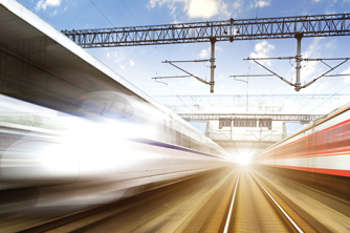The rail industry has set out how it will cope with ever-increasing demand by using technology and advanced design to get more people on trains and more trains on the network.
The plans include Bluetooth and eventually biometric ticketing, new seats to create more space and trains running closer together on a digital railway.

This is the age of the digital train
The Rail Delivery Group (RDG), which represents train operators and Network Rail, said over 200 individual research, design and technology projects will help provide an increasingly efficient and flexible rail network.
Paul Plummer, RDG chief executive said: ‘Our railway is increasingly full and while the industry is taking action to address the challenges of today, working together to deliver the £50bn plus Railway Upgrade Plan, we also need to be looking at the solutions of tomorrow.
‘This blueprint sets out how we can harness digital technology to make journeys better for passengers and freight customers on a railway that’s simpler and easier to use.’
New technology includes a mobile app that aids the flow of passengers through ticket gates, using Bluetooth technology to charge passengers against their travel account.
It will be trialled this year by Chiltern Railways on their new route between Oxford Parkway and London Marylebone and could eventually give way to biometric technology – such as fingerprint or iris-scanning.
The RDG said new seat designs would both improve comfort and increase the amount of space for passengers on both new and existing trains.
One new seat type allows between 20-30% more seats, allowing passengers to sit in a more upright position, while another type provides traditional seats during the day, but converts to a different configuration during peak times, allowing up to 15-20% more seats and more room for people who stand.
The RDG said fully ‘intelligent’ trains that communicate with each other would make efficient use of the railway network. A £450m investment announced in the Autumn Statement will see new signalling technology trialled, which the RDG said is the first step toward developing trains which will be able to operate autonomously and closer together.
The ideas are set out in the RDG’s Capability Delivery Plan (CDP), which is part of a wider Rail Technical Strategy.
Register now for full access
Register just once to get unrestricted, real-time coverage of the issues and challenges facing UK transport and highways engineers.
Full website content includes the latest news, exclusive commentary from leading industry figures and detailed topical analysis of the highways, transportation, environment and place-shaping sectors.
Use the link below to register your details for full, free access.
Already a registered? Login